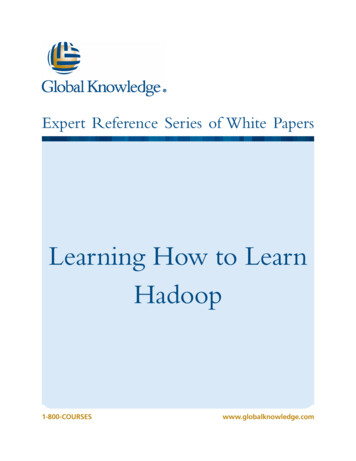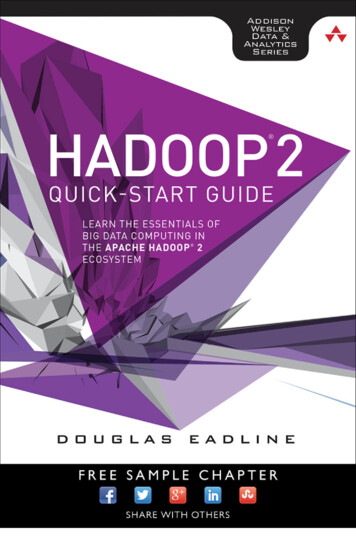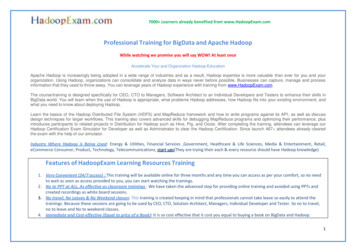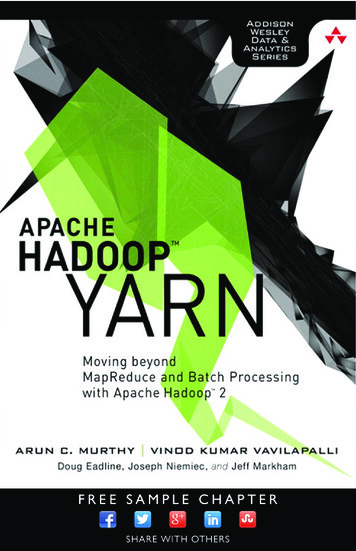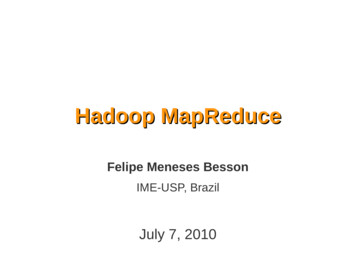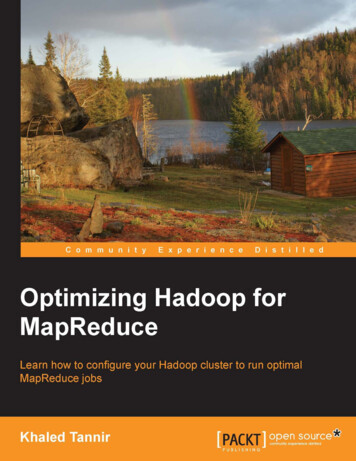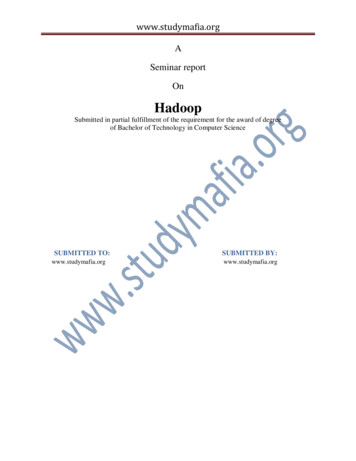
Transcription
www.studymafia.orgASeminar reportOnHadoopSubmitted in partial fulfillment of the requirement for the award of degreeof Bachelor of Technology in Computer ScienceSUBMITTED TO:www.studymafia.orgSUBMITTED BY:www.studymafia.org
www.studymafia.orgAcknowledgementI would like to thank respected Mr . and Mr. .for giving me such a wonderfulopportunity to expand myknowledge for my own branch and giving me guidelines topresent a seminar report. It helped me a lot to realize of what we study for.Secondly, I would like to thank my parents who patiently helped me as i went through my workand helped to modify and eliminate some of the irrelevant or un-necessary stuffs.Thirdly, I would like to thank my friends who helped me to make my work more organized andwell-stacked till the end.Next, I would thank Microsoft for developing such a wonderful tool like MS Word. It helped mywork a lot to remain error-free.Last but clearly not the least, I would thank The Almighty for giving me strength to complete myreport on time.
www.studymafia.orgPrefaceI have made this report file on the topic Hadoop; I have tried my best to elucidate all the relevantdetail to the topic to be included in the report. While in the beginning I have tried to give ageneral view about this topic.My efforts and wholehearted co-corporation of each and everyone has ended on a successfulnote. I express my sincere gratitude to .who assisting me throughout the preparation ofthis topic. I thank him for providing me the reinforcement, confidence and most importantly thetrack for the topic whenever I needed it.
www.studymafia.orgIntroductionHadoop is an Apache open source framework written in java that allows distributed processingof large datasets across clusters of computers using simple programming models. A Hadoopframe-worked application works in an environment that provides distributed storage andcomputation across clusters of computers. Hadoop is designed to scale up from single server tothousands of machines, each offering local computation and storage.What is Hadoop?Hadoop is sub-project of Lucene (a collection of industrial-strength search tools), under theumbrella of the Apache Software Foundation. Hadoop parallelizes data processing across manynodes (computers) in a compute cluster, speeding up large computations and hiding I/O latencythrough increased concurrency. Hadoop is especially well-suited to large data processing tasks(like searching and indexing) because it can leverage its distributed file system to cheaply andreliably replicate chunks of data to nodes in the cluster, making data available locally on themachine that is processing it.Hadoop is written in Java. Hadoop programs can be written using a small API in Java or Python.Hadoop can also run binaries and shell scripts on nodes in the cluster provided that they conformto a particular convention for string input/output.Hadoop provides to the application programmer the abstraction of map and reduce (which maybe familiar to those with functional programming experience). Map and reduce are available inmany languages, such as Lisp and Python.
www.studymafia.orgHadoop ApplicationsMaking Hadoop Applications More Widely AccessibleApache Hadoop, the open source MapReduce framework, has dramatically lowered the costbarriers to processing and analyzing big data. Technical barriers remain, however, since Hadoopapplications and technologies are highly complex and still foreign to most developers and dataanalysts. Talend, the open source integration company, makes the massive computing power ofHadoop truly accessible by making it easy to work with Hadoop applications and to incorporateHadoop into enterprise data flows.A Graphical Abstraction Layer on Top of HadoopApplicationsIn keeping with our history as an innovator and leader in open source data integration, Talend isthe first provider to offer a pure open source solution to enable big data integration. Talend OpenStudio for Big Data, by layering an easy to use graphical development environment on top ofpowerful Hadoop applications, makes big data management accessible to more companies andmore developers than ever before.With its Eclipse-based graphical workspace, Talend Open Studio for Big Data enables thedeveloper and data scientist to leverage Hadoop loading and processing technologies like HDFS,HBase, Hive, and Pig without having to write Hadoop application code. By simply selectinggraphical components from a palette, arranging and configuring them, you can create Hadoopjobs that, for example: Load data into HDFS (Hadoop Distributed File System)Use Hadoop Pig to transform data in HDFSLoad data into a Hadoop Hive based data warehousePerform ELT (extract, load, transform) aggregations in HiveLeverage Sqoop to integrate relational databases and Hadoop
www.studymafia.orgHadoop Applications, Seamlessly IntegratedFor Hadoop applications to be truly accessible to your organization, they need to be smoothlyintegrated into your overall data flows. Talend Open Studio for Big Data is the ideal tool forintegrating Hadoop applications into your broader data architecture. Talend provides more builtin connector components than any other data integration solution available, with more than 800connectors that make it easy to read from or write to any major file format, database, orpackaged enterprise application.For example, in Talend Open Studio for Big Data, you can use drag 'n drop configurablecomponents to create data integration flows that move data from delimited log files into HadoopHive, perform operations in Hive, and extract data from Hive into a MySQL database (or Oracle,Sybase, SQL Server, and so on).Want to see how easy it can be to work with cutting-edge Hadoop applications? No need to wait-- Talend Open Studio for Big Data is open source software, free to download and use under anApache license.
www.studymafia.orgHadoop ArchitectureHadoop framework includes following four modules: Hadoop Common: These are Java libraries and utilities required by other Hadoopmodules. These libraries provides filesystem and OS level abstractions and contains thenecessary Java files and scripts required to start Hadoop.Hadoop YARN: This is a framework for job scheduling and cluster resourcemanagement.Hadoop Distributed File System (HDFS ): A distributed file system that provideshigh-throughput access to application data.Hadoop MapReduce: This is YARN-based system for parallel processing of large datasets.We can use following diagram to depict these four components available in Hadoop framework.
www.studymafia.orgSince 2012, the term "Hadoop" often refers not just to the base modules mentioned above butalso to the collection of additional software packages that can be installed on top of or alongsideHadoop, such as Apache Pig, Apache Hive, Apache HBase, Apache Spark etc.MapReduceHadoop MapReduce is a software framework for easily writing applications which process bigamounts of data in-parallel on large clusters (thousands of nodes) of commodity hardware in areliable, fault-tolerant manner.The term MapReduce actually refers to the following two different tasks that Hadoop programsperform: The Map Task: This is the first task, which takes input data and converts it into a set ofdata, where individual elements are broken down into tuples (key/value pairs).The Reduce Task: This task takes the output from a map task as input and combinesthose data tuples into a smaller set of tuples. The reduce task is always performed afterthe map task.Typically both the input and the output are stored in a file-system. The framework takes care ofscheduling tasks, monitoring them and re-executes the failed tasks.The MapReduce framework consists of a single master JobTracker and one slave TaskTrackerper cluster-node. The master is responsible for resource management, tracking resourceconsumption/availability and scheduling the jobs component tasks on the slaves, monitoringthem and re-executing the failed tasks. The slaves TaskTracker execute the tasks as directed bythe master and provide task-status information to the master periodically.The JobTracker is a single point of failure for the Hadoop MapReduce service which means ifJobTracker goes down, all running jobs are halted.
www.studymafia.orgWhy is Hadoop important? Ability to store and process huge amounts of any kind of data, quickly. With datavolumes and varieties constantly increasing, especially from social media and the Internetof Things (IoT), that's a key consideration.Computing power. Hadoop's distributed computing model processes big data fast. Themore computing nodes you use, the more processing power you have.Fault tolerance. Data and application processing are protected against hardware failure.If a node goes down, jobs are automatically redirected to other nodes to make sure thedistributed computing does not fail. Multiple copies of all data are stored automatically.Flexibility. Unlike traditional relational databases, you don’t have to preprocess databefore storing it. You can store as much data as you want and decide how to use it later.That includes unstructured data like text, images and videos.Low cost. The open-source framework is free and uses commodity hardware to storelarge quantities of data.Scalability. You can easily grow your system to handle more data simply by addingnodes. Little administration is required.
www.studymafia.orgHadoop Distributed File SystemHadoop can work directly with any mountable distributed file system such as Local FS, HFTPFS, S3 FS, and others, but the most common file system used by Hadoop is the HadoopDistributed File System (HDFS).The Hadoop Distributed File System (HDFS) is based on the Google File System (GFS) andprovides a distributed file system that is designed to run on large clusters (thousands ofcomputers) of small computer machines in a reliable, fault-tolerant manner.HDFS uses a master/slave architecture where master consists of a single NameNode thatmanages the file system metadata and one or more slave DataNodes that store the actual data.A file in an HDFS namespace is split into several blocks and those blocks are stored in a set ofDataNodes. The NameNode determines the mapping of blocks to the DataNodes. TheDataNodes takes care of read and write operation with the file system. They also take care ofblock creation, deletion and replication based on instruction given by NameNode.HDFS provides a shell like any other file system and a list of commands are available to interactwith the file system. These shell commands will be covered in a separate chapter along withappropriate examples.How Does Hadoop Work?Stage 1A user/application can submit a job to the Hadoop (a hadoop job client) for required process byspecifying the following items:1. The location of the input and output files in the distributed file system.2. The java classes in the form of jar file containing the implementation of map and reducefunctions.3. The job configuration by setting different parameters specific to the job.Stage 2The Hadoop job client then submits the job (jar/executable etc) and configuration to theJobTracker which then assumes the responsibility of distributing the software/configuration tothe slaves, scheduling tasks and monitoring them, providing status and diagnostic information tothe job-client.Stage 3The TaskTrackers on different nodes execute the task as per MapReduce implementation andoutput of the reduce function is stored into the output files on the file system.
www.studymafia.orgAdvantages of Hadoop1. ScalableHadoop is a highly scalable storage platform, because it can stores and distribute very large datasets across hundreds of inexpensive servers that operate in parallel. Unlike traditional relationaldatabase systems (RDBMS) that can’t scale to process large amounts of data, Hadoop enablesbusinesses to run applications on thousands of nodes involving many thousands of terabytes ofdata.2. Cost effectiveHadoop also offers a cost effective storage solution for businesses’ exploding data sets. Theproblem with traditional relational database management systems is that it is extremely costprohibitive to scale to such a degree in order to process such massive volumes of data. In aneffort to reduce costs, many companies in the past would have had to down-sample data andclassify it based on certain assumptions as to which data was the most valuable. The raw datawould be deleted, as it would be too cost-prohibitive to keep. While this approach may haveworked in the short term, this meant that when business priorities changed, the complete rawdata set was not available, as it was too expensive to store.3. FlexibleHadoop enables businesses to easily access new data sources and tap into different types of data(both structured and unstructured) to generate value from that data. This means businesses canuse Hadoop to derive valuable business insights from data sources such as social media, emailconversations. Hadoop can be used for a wide variety of purposes, such as log processing,recommendation systems, data warehousing, market campaign analysis and fraud detection.4. FastHadoop’s unique storage method is based on a distributed file system that basically ‘maps’ datawherever it is located on a cluster. The tools for data processing are often on the same serverswhere the data is located, resulting in much faster data processing. If you’re dealing with largevolumes of unstructured data, Hadoop is able to efficiently process terabytes of data in justminutes, and petabytes in hours.5. Resilient to failureA key advantage of using Hadoop is its fault tolerance. When data is sent to an individual node,that data is also replicated to other nodes in the cluster, which means that in the event of failure,there is another copy available for use.
www.studymafia.orgDisadvantages of Hadoop:As the backbone of so many implementations, Hadoop is almost synomous with big data.1. Security ConcernsJust managing a complex applications such as Hadoop can be challenging. A simple example canbe seen in the Hadoop security model, which is disabled by default due to sheer complexity. Ifwhoever managing the platform lacks of know how to enable it, your data could be at huge risk.Hadoop is also missing encryption at the storage and network levels, which is a major sellingpoint for government agencies and others that prefer to keep their data under wraps.2. Vulnerable By NatureSpeaking of security, the very makeup of Hadoop makes running it a risky proposition. Theframework is written almost entirely in Java, one of the most widely used yet controversialprogramming languages in existence. Java has been heavily exploited by cybercriminals and as aresult, implicated in numerous security breaches.3. Not Fit for Small DataWhile big data is not exclusively made for big businesses, not all big data platforms are suitedfor small data needs. Unfortunately, Hadoop happens to be one of them. Due to its high capacitydesign, the Hadoop Distributed File System, lacks the ability to efficiently support the randomreading of small files. As a result, it is not recommended for organizations with small quantitiesof data.4. Potential Stability IssuesLike all open source software, Hadoop has had its fair share of stability issues. To avoid theseissues, organizations are strongly recommended to make sure they are running the latest stableversion, or run it under a third-party vendor equipped to handle such problems.5. General LimitationsThe article introducesApache Flume, MillWheel, and Google’s own Cloud Dataflow as possiblesolutions. What each of these platforms have in common is the ability to improve the efficiencyand reliability of data collection, aggregation, and integration. The main point the article stressesis that companies could be missing out on big benefits by using Hadoop alone.
www.studymafia.orgHow Is Hadoop Being Used?Low-cost storage and data archiveThe modest cost of commodity hardware makes Hadoop useful for storing and combining datasuch as transactional, social media, sensor, machine, scientific, click streams, etc. The low-coststorage lets you keep information that is not deemed currently critical but that you might want toanalyze later.Sandbox for discovery and analysisBecause Hadoop was designed to deal with volumes of data in a variety of shapes and forms, itcan run analytical algorithms. Big data analytics on Hadoop can help your organization operatemore efficiently, uncover new opportunities and derive next-level competitive advantage. Thesandbox approach provides an opportunity to innovate with minimal investment.Data lakeData lakes support storing data in its original or exact format. The goal is to offer a raw orunrefined view of data to data scientists and analysts for discovery and analytics. It helps themask new or difficult questions without constraints. Data lakes are not a replacement for datawarehouses. In fact, how to secure and govern data lakes is a huge topic for IT. They may rely ondata federation techniques to create a logical data structures.Complement your data warehouseWe're now seeing Hadoop beginning to sit beside data warehouse environments, as well ascertain data sets being offloaded from the data warehouse into Hadoop or new types of datagoing directly to Hadoop. The end goal for every organization is to have a right platform forstoring and processing data of different schema, formats, etc. to support different use cases thatcan be integrated at different levels.IoT and HadoopThings in the IoT need to know what to communicate and when to act. At the core of the IoT is astreaming, always on torrent of data. Hadoop is often used as the data store for millions orbillions of transactions. Massive storage and processing capabilities also allow you to useHadoop as a sandbox for discovery and definition of patterns to be monitored for prescriptiveinstruction. You can then continuously improve these instructions, because Hadoop is constantlybeing updated with new data that doesn’t match previously defined patterns.
www.studymafia.orgReference www.google.comwww.wikipedia.orgwww.studymafia.org
www.studymafia.org Introduction Hadoop is an Apache open source framework written in java that allows distributed processing of large datasets across clusters of computers using simple programming models. A Hadoop frame-worked application works in an environment that provides distribu





